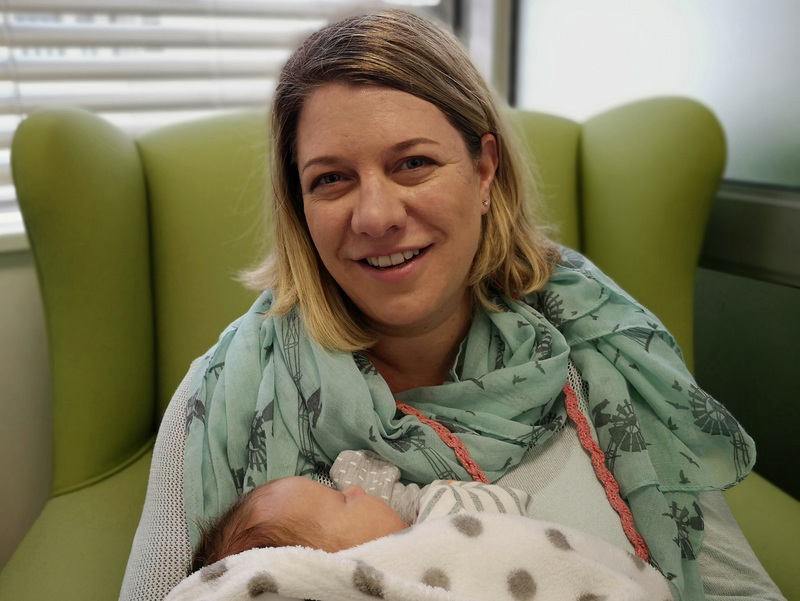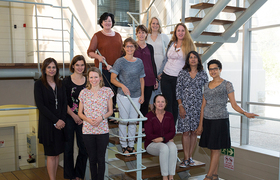New breastfeeding room at Red Cross Hospital
01 August 2018 | Story Sarah Middleton. Photo Supplied. Read time 6 min.
In line with global and national efforts to promote breastfeeding-friendly workplaces, a dedicated breastfeeding room was launched on Tuesday, 31 July, at Red Cross War Memorial Children’s Hospital.
Thanks to the combined efforts of hospital management and the Children’s Hospital Trust, the women now have a hygienic, comfortable facility in which to breastfeed or express milk, and a fridge for storing the milk safely.
The breastfeeding room has been championed by the Child Health Advocacy Committee of the UCT Department of Paediatrics and Child Health.
Lori Lake, co-chair of the Advocacy Committee, said, “About two years ago we hosted a clinical lecture where we were focusing on breastfeeding, and the room erupted with working mothers who were describing their experiences of trying to breastfeed in broom cupboards and in toilets and expressing a great deal of anger and frustration.
“Working mothers ... were describing their experiences of trying to breastfeed in broom cupboards and in toilets and expressing a great deal of anger and frustration.”
“Out of that process we’ve been working with the hospital and pushing for the development of a breastfeeding room that provides a space for women to breastfeed in privacy, in dignity, and in a clean and healthy environment.”
Mother and child health
She added, “There’s a lot of work that has been done around this globally, and locally the National Department of Health is focusing attention on the first 1 000 days of life and looking at creating mother and child friendly facilities.”
Investing in breastfeeding is the most effective single intervention in reducing child mortality, according to the 2016 Lancet Breastfeeding Series.
Breast milk contains a powerful combination of vitamins, minerals, nutrients and antibodies specifically tailored to meet an infant’s changing nutritional needs. Yet very few mothers in South Africa exclusively breastfeed for the first six months of life. These low exclusive breastfeeding rates contribute to the high prevalence of malnutrition, diarrhoea, pneumonia and under-five mortality in South Africa.
“The breastfeeding room is another key part of the broader strategy to promote mother and child health,” said Lake.
“The breastfeeding room is another key part of the broader strategy to promote mother and child health.”
A breastfeeding-friendly policy
The launch of the facility at the hospital is significant as it encourages the recognition that all workplaces should be mother and child friendly, said Lake.
“This is very often a blind spot in terms of company policies. Women have to navigate the return to work on their own, with very little institutional support and, very often, little awareness of their entitlements,” she said.
“We are hoping that it will serve as an inspiration and as a stimulus for other departments at UCT to establish similar spaces for women, for the university to develop a breastfeeding-friendly policy, and for the same kind of initiative to be taken up by government, other businesses and trade unions. So that all working women who wish to continue breastfeeding their children are given adequate support, so that their children can have the best possible start in life.”
Support at home
The next goal of the Advocacy Committee is to gain greater investment in community health workers who can provide counselling and support to mothers in their homes.
“What we know is that, in South Africa, by far the majority of women initiate breastfeeding before they leave the hospital, but there are a number of critical points once they return home when they need additional support and guidance and, equally, planning ahead for the return to work.”
The committee will also be looking at the role of men in mother and child health. Fathers and other family members can help to ensure that women feel more supported and less stressed within the home environment.
Support in the workplace
The Child Health Advocacy Committee offers the following pointers for employers to support breastfeeding women in the workplace:
1. Time
Women are entitled to two 30-minute breaks in order to express milk or breastfeed their baby. Create a more flexible work schedule so that women can express milk when they need to. If possible, give mothers options to extend maternity leave, work from home, or work part-time so that they can continue breastfeeding, or provide child care on site or close to work.
2 Space
Set aside a small, private room for breastfeeding. No woman should be expected to express milk or breastfeed in the toilet. This is not a clean and healthy environment in which to prepare baby food. Breastmilk can be refrigerated or stored in a personal cooler.
3. Develop a clear policy and guidelines
Take active steps to create a supportive work environment. Develop a clear policy and extend provision of breastfeeding or expressing breaks from six to 12 months to support mothers and infants as they make the transition to solid food.
4. Educate staff and management
Educate staff about the policy and the benefits of breastfeeding. Enlist the support of supervisors and co-workers. Inform pregnant women about their rights – to maternity leave and breastfeeding breaks – so that they can plan ahead and continue breastfeeding.
 This work is licensed under a Creative Commons Attribution-NoDerivatives 4.0 International License.
This work is licensed under a Creative Commons Attribution-NoDerivatives 4.0 International License.
Please view the republishing articles page for more information.










